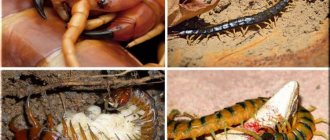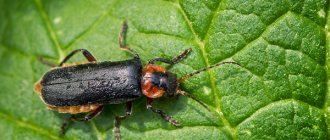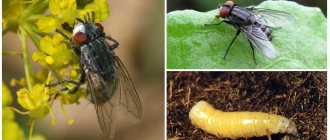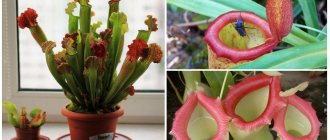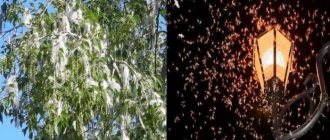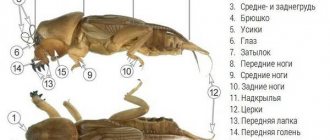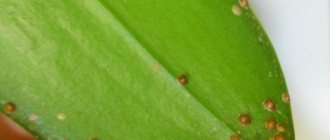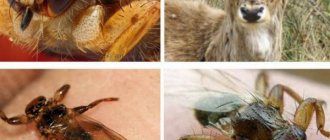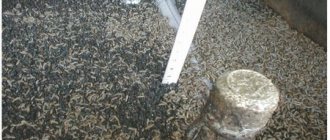Varieties
Mining flies have a fairly high food specialization, that is, larvae of different species feed on certain tissues of specific plant species. Most species of leafminers have larvae that eat leaves, but there are species whose larvae feed on fruits, roots, inflorescences, or bulbs. For example, bulb fly larvae damage garlic and onion bulbs, which become soft and rot.
Beet
Beet leaf miners cause great harm. Their larvae feed on the leaves of beets, spinach, and other types of nightshades. In addition, they can eat wild goosefoot
and nightshades. Adults reach 6–8 mm in length. Flies lay eggs on the underside of leaves. Several eggs are laid at a time; one female can lay up to 100 eggs in her lifetime. After four to five days, fly larvae emerge from the eggs and make passages in the leaves (in other words, they mine them). On the surface of the leaf, these mines are visible as dirty yellow swellings. Having settled on young beet plants, the larvae of leaf miners often lead to the death of seedlings. At later stages of development, infection by leafmining flies leads to a decrease in the weight of root crops. Under favorable conditions, three generations of beet flies can change over the summer. Flies pupate in the ground, and in the ground they overwinter in the form of pupae (fly pupae are also called false cocoons).
Solanaceae
The so-called nightshade miners are tiny flies, only 2-2.5 mm long. These insects
damage cucumbers, tomatoes, cabbage, lettuce, parsley, celery and melons. Females of the first generation lay eggs in cotyledons or young leaves. Larvae that appear in early spring sometimes cause the death of young plants. When flies lay eggs on leaves, this is noticeable by yellow puncture marks.
The hatched larvae form clearly visible passages, or mines, in the leaves. Inside the mines you can see a dark trail of larval excrement. About three weeks after birth, the larva gnaws its way out, falls to the ground, buries itself in the soil and forms a pupa, from which an adult fly emerges a few days later. Having multiplied in large numbers, the leaf miners retard the growth of plants, and the affected leaves dry out and fall off. But even a small number of miners reduces crop productivity.
How a mine is laid
Mines in plant leaves are always eaten by the leaf miner larva, but to do this, an adult female leaf miner must first land on the plant and lay an egg on it.
During the mass flight of leafmining flies, large numbers of them can be observed on the leaves and shoots of plants. If the fly moves along the leaf, leaving a small bubble of whitish, milky green or yellowish color on it, this means that egg laying is in full swing.
The larvae of many types of leaf miners do not bother to emerge to the leaf surface. They bite into leaf tissue using the shortest route – through the wall of the egg. In this case, the result is a camouflaged mine, the entrance to which is closed by the shell of the egg. After a week, the entrance to the mine becomes overgrown, and the larva becomes isolated from the external environment.
Root nematode: what harm does it cause to cucumbers, description and methods of control
This is a worm 1.5 mm long. His favorite habitats are: greenhouses, greenhouses. Having penetrated the roots of the plant, the nematode settles there.
How to find out that cucumbers are infected with this pest
1. An infected cucumber bush lags behind similar ones in growth. 2. The harvest was obtained in a reduced volume. 3. You can observe that unsightly “bumps” have appeared on the roots - these are the places where nematode larvae mature.
What to do to destroy the worm on cucumbers:
It is difficult to eliminate a nematode if it has already appeared in the greenhouse. It is worth taking preventive actions: In the garden bed, in open ground, where cucumbers grow, you need to plant cabbage and garlic. Weeds, every single one, must be destroyed so that the nematodes have nothing to eat.
The soil is watered with boiling water. Then cover it with film for 2 or 3 hours. As soon as pests that destroy cucumbers are discovered, the top layer of soil must be removed. As an option, the soil is frozen, but the worms may not die.
When individual roundworms become visible, it is imperative to dig up the infected cucumber bush, as well as the bushes on the right and left. The roots and soil should be treated with a 5% formaldehyde solution or 2% carbation. The soil is covered with polyethylene.
External signs of damage
It is very easy to notice the leaf miner on the leaves: punctures from the females of this parasite become the first to become obvious. Depending on the type of plant, the nature of the damage will differ, so external signs should be considered separately for specific groups.
Fruit trees
Most often, miners settle on apple, pear and cherry trees. Trees have been mined for several years and begin to dry out from the top. The mines are different shades of brown and have a snake-like or even bubbly shape. Affected leaves need to be removed; yellow boards are used to catch flies.
Flowers
Flower miners are most often found on violets, zinnias and chrysanthemums. They differ in shades and tortuosity of the lesion traces. If burrows are detected, the leaves must be urgently removed and the plant must be sprayed with a pyrethrum-based preparation.
Shrubs
Roses, rhododendron, and holly are especially at risk. Miners leave puncture points, which over time turn into long passages with many convolutions.
Vegetables
On the leaves of tomatoes, cucumbers, and lettuce, you can notice long strokes, usually of a light shade. To catch miners, you can also use yellow signs or send riders into the greenhouse. However, details about methods of combating miners in different ways are written in the final parts of the material.
How does the germ fly develop?
The first generation of the pest appears in the spring at the junction of April and May. This moment may shift by 10 days in one direction or another, depending on the region. Having fed on nectar and pollen, the flies begin to mate. Soon the eggs are laid. One female lays 50 to 60 eggs at a time in wet manure.
Females especially prefer to lay eggs in the manured soil of cucumber beds. Embryonic development lasts from 4 to 10 days, the period depends on soil temperature. Born larvae are characterized by increased mobility.
They immediately begin to move in the beds, in search of germinating seeds. Having found such a seed, the larvae gnaw through the place where the sprouts appear and eat the contents of the seeds from the inside. The seedlings die from such exposure.
The speed of larval development depends on the abundance of food and temperature. This may take from 10 to 40 days. When the pupation stage approaches, the larvae reach their maximum length, their bodies thicken, and their color becomes dirty whitish.
The larvae pupate in the soil layer, in the summer at a depth of 5 cm, and in the fall the process occurs at a depth of 9 cm. The shell of the pupa is quite hard, it is colored brown-yellow. At the end of the shell there are 4 strong teeth.
The sprout fly stays in the pupal stage for different periods of time. In summer, this period lasts from 12 to 20 days, and wintering pupae remain in this state for 180 days. An adult fly flies out of the pupae and this completes the insect’s development cycle.
Attention! In areas with a warm climate, females can give up to 4 generations of the pest per season, and in regions with a cool climate - no more than 2 generations.
What to spray against melon aphids
Aphids are small yellowish or dark green insects that cling to the underside of leaves, buds, fruit ovaries, and the tops of young shoots in entire colonies. They feed on plant sap. As a result, the leaves wrinkle, become deformed, and the buds fall off.
The cucumber bush practically stops growing, then dries and dies. Aphids are dangerous not only in themselves - they carry many dangerous microorganisms, for example, sooty fungus.
The melon aphid is a pest that is very easy to notice.
If the problem is noticed in a timely manner, when there are still a few aphids, you can simply wash it off the bush by hosing the cucumbers with a stream of water under strong pressure. If there is no technical possibility, the leaves are simply wiped with soap suds.
Melon aphids cling to young cucumber leaves in a dense layer
Treatment of cucumbers against aphids with folk remedies
Folk remedies are good mainly for preventing aphids. Cucumbers growing in a greenhouse are sprayed with appropriate solutions every 7-10 days, in open ground - after each rain. Any product with a strong, pungent odor will do. He is very unpleasant to aphids.
onion peel (100 g per 2.5–3 liters of boiling water, leave for 24 hours); garlic (a head crushed into a pulp per liter of hot water, leave for 2-3 days, dilute with water 1:5 before use); hot pepper (30 g of finely chopped pods or 10–15 g of powder per 10 liters of water, leave for 24 hours); tobacco crumbs (it is advisable that the tobacco is grown independently, 200 g of dry leaves per 10 liters of water, leave for 2-3 days, add a liter jar of sifted wood ash before use); dandelion leaves or roots (pass 400–500 g through a meat grinder, add 5 liters of water, let stand for 2–3 hours, add 30–40 g mustard powder before use); tops of tomatoes or potatoes (200 g of crushed raw materials per 5 liters of water, leave for 10–12 hours, add 25–30 g of soda ash before spraying).
An infusion of onion peels, like other products with pungent odors, is an effective remedy against melon aphids
Other methods of struggle
If time is lost and the pest has multiplied en masse, the most affected leaves and whole vines are cut off and burned as quickly as possible. The remaining plants in the greenhouse are fumigated with sulfur bombs, in the open ground they are sprayed with a solution of Karbofos (50 g per 10 liters of water) or dusted with colloidal sulfur powder.
When there is no effect, insecticides are used. Broad-spectrum drugs are mainly used against aphids - Inta-Vir, Fitoverm, Aktaru, Konfidor, Fufanon, Karate. Biological preparations - Biotlin, Iskra-Bio, Strela - cause less harm to plants (the fruits can be eaten 2-3 days after spraying). The solution for treating plants is prepared in strict accordance with the instructions given by the manufacturer in the instructions. The procedure is repeated every 4–7 days until the pest is completely destroyed. It is advisable to change medications at the same time.
Spicy herbs are a good protection against aphids. You can surround the beds or plant basil, coriander, lemon balm, mint, and dill mixed with bushes. Datura and henbane will also help, but they are very poisonous. Most of these plants are good honey plants and attract natural enemies of aphids - ladybugs - to the garden. By the way, if you wish, you can simply collect them somewhere and release them into a greenhouse or garden beds.
Inta-Vir is one of the most common broad-spectrum insecticides
Do not forget that aphids live in a stable symbiosis with ants.
The latter will also have to be fought. The top layer of soil (5–7 cm) is removed from anthills found near the bed and the soil is sprinkled with soda ash, mustard, hot pepper, boric acid, or the soil is spilled with a solution of special preparations, for example, Anteater or ordinary boiling water.
How to protect cucumbers with proper agricultural technology
In order to protect cucumber plantings from the sprout fly, you need to take a number of preventive measures.
The first step is to make it a rule to cultivate the soil for planting cucumbers, deep digging twice a year.
Digging up the soil in late autumn, when frosts begin, is especially effective. The insect larvae raised to the top freeze and die. You should also strictly follow the time limits for sowing seeds in open and protected soil recommended for your region.
Biological remedies
The sprout fly has fierce enemies who destroy it mercilessly. These are predators and parasites that pursue flies at all stages of their development. Among them, the most voracious are beetles from the genus Aleohara and the dipterous Ktyri. As for parasites, the greatest damage to sprout flies is caused by parasites from the Eucoilidae family.
Greenhouses and greenhouses are inhabited by nematode parasites from the families Cephalobidae and Rhabditidae. Natural control measures successfully protect cucumbers from sprout flies.
Also, some mushrooms are deadly to them. The strongest of them are considered to be representatives of the Fusarium family, as well as the mushroom Entomophtora muscae.
Chemical remedies
Chemical preparations to protect cucumbers from sprout flies are used only when there are too many of them on the plantation or in the greenhouse. There are many such special tools:
- "Detox";
- "Cyperus";
- "Fufanon";
- "Karbofos".
Before use, you must carefully study the instructions and dosages for proper processing.
The use of products intended for seed treatment also gives good results. For these purposes, you can use the insecticides “Aktellik” or “Iskra”. As for the mandatory treatment of the soil with chemicals, summer residents advise adding some granular insecticides to the soil.
Folk recipes
If the pest has not managed to take over the entire garden area, then you can begin to fight it using folk remedies that are designed to scare away the fly trying to lay eggs. For example, to confuse the pest, you can treat a cucumber plantation with an infusion of hot pepper or wormwood. Does not like insects and plants dusted with a mixture of ash, lime, tobacco dust and mustard powder.
According to gardeners, there is another effective measure to combat the sprout fly - limiting the insect's access to seedlings. To do this, cover the beds with non-woven material.
It is important to start fighting the pest immediately as soon as it is noticed on the site, and do not forget about preventive measures.
Preventing the appearance of onion flies
In order not to think about how to water plants eaten by the larvae of a parasitic insect, it is advisable to know about preventive measures against onion flies that will help prevent the appearance of the pest in your summer cottage.
One of the most effective preventive methods is the organization of crop rotation. The same crop cannot be planted in the same place for several years in a row. And if, for example, strawberries need to be replanted once every 4 years, then it is advisable to change the location of onions every year. You can plant onions in the same area once every 3-4 years. Planting companion crops
When planning planting, you need to take into account that each pest does not like certain odors. So, for example, the onion fly cannot stand the smell of carrots, so it is advisable to plant carrots next to onion crops
It’s better to alternate the beds, then the likelihood of onion flour appearing will be minimal. In addition, the carrot fly is afraid of the smell of onions. By planting vegetables close to each other, you will be able to repel 2 pests at the same time. In the fall you need to dig up the soil. Since the onion fly overwinters at a depth of 15-20 cm, you need to dig the soil deeply. Before planting, it is advisable to warm up all planting material at a temperature of 25°C, and immediately before planting, soak the bulbs in a solution consisting of a tablespoon of table salt and 1 liter of water. If necessary, you need to increase the amount of solution without changing the salt concentration. After 3 hours, you can take out the bulbs, rinse them well and dip them in a solution of potassium permanganate, then leave the planting material there for 2 hours. Watering, which is an integral part of plant care, should be done with herbal decoctions that repel pests. You should not water the plant with solutions every time, even if they do not contain chemicals. But 2 times a month it makes sense to water with means that protect against onion flies. After all, saving the crop is harder than preventing the appearance of a pest.
How to treat cruciferous (black) flea beetle
The cruciferous flea beetle is a small (up to 3 mm) bug of black color and round shape, most often with a glossy shiny shell, shimmering green or blue. Pests become active already in mid-spring, when the air temperature rises to 12–15ºС. The larvae are not particularly picky, feeding on roots and greens. The leaves quickly turn into a sieve and dry.
The black flea beetle is easily identified by its long legs
The main thing in the fight against cruciferous flea beetle is to calculate the time correctly. Early varieties of cucumbers are planted as early as possible (in April), late-ripening ones - later (in the second ten days of July). Thus, before the beginning of May or mid-August, when the massive appearance of these insects is noted, the cucumber bushes will have time not only to grow, but also to “coarse” slightly. The pest prefers young, soft leaves, so there is every chance that the flea will “pass by.”
The black flea beetle received its official name due to the fact that, until more suitable food becomes available, it feeds on weeds from the Cruciferous family (colts, shepherd's purse, wild radish). Therefore, you need to weed the beds regularly. Any covering material - spunbond, lutrasil, agrospan - will also provide effective protection. It is advisable to pull it over the arcs and remove it when the bushes are strong enough.
The black flea beetle turns cucumber leaves into a real sieve
The black flea beetle is very sensitive to strong odors. Therefore, cucumbers in the greenhouse and in the open ground alternate with dill, garlic, basil, and coriander. The beds are surrounded by a “barrier” of marigolds, nasturtiums, calendula, and wormwood.
Folk remedies
The experience of many gardeners shows that the black flea beetle rarely attacks “dirty” plants.
Therefore, cucumber bushes, especially young ones, are regularly sprinkled with crushed chalk or activated carbon, sifted wood ash, tobacco dust, and hot pepper. The powder is poured into a gauze bag and shaken over the plants. It is best to carry out the procedure early in the morning, when the leaves are still wet. Mothballs are scattered in moderate quantities in the grooves between the bushes.
For spraying, use solutions of the following products:
Minced garlic and tomato tops. The raw materials are mixed in a ratio of approximately 1:1, pour 10 liters of warm water, and leave for 2–3 hours. The solution is filtered before use. Table (9%) vinegar. 200 ml per 10 liters of water. Stir thoroughly and can be used immediately. Potato tops. Grind 4 kg of raw materials and boil for 2–3 hours. Then the broth is cooled, filtered and diluted with water 1:1. Chicken droppings. Fresh raw materials are infused for 4–5 days until a characteristic odor appears. Then dilute with water 1:20 and spray the leaves. It is also an effective foliar feeding. Aromatic oils of any coniferous trees, tincture of Corvalol, valerian. 10–15 drops per bucket of water is enough.
An infusion of chicken manure is not only an effective remedy against black fleas, but also a useful supplement.
You can also hang “flags” made of fabric smeared with something sticky next to the bushes. In the hottest weather, it is useful to walk along the bed with such a trap, waving it so as to touch the leaves. Disturbed insects, jumping in different directions, stick to the fabric.
To combat the black flea, it is recommended to use used machine oil (they lubricate pieces of plywood or cardboard with it and leave it in the rows) or a regular vacuum cleaner. Early in the morning, when pests are least active, they can walk on the plants. Flea shampoo intended for pets (50 ml per 10 liters of water) is also successfully used.
Proper care is important.
Cucumbers need abundant watering (the black flea beetle does not like high humidity), proper fertilizing (nitrogen-containing fertilizers are needed - natural organic matter, ammonium nitrate, urea), and regular loosening of the beds.
Insecticides to combat black flea beetles are used only in case of massive insect attacks. Most of them (for example, Lightning, Decis) are quite toxic and destroy not only pests, but also young cucumber seedlings. The safest for humans are Arrivo, Aktara, Sherpa. Treatments are carried out in the late evening, when fleas accumulate on the leaves.
Insecticides against black flea beetles are used only as a last resort.
Mining fly, description, photo, why it is dangerous, how and how to fight it
The leaf miner is a two-winged insect that is a rather dangerous pest of indoor plants and vegetable crops, as well as trees.
There are more than 3 thousand species of this fly in the world, the largest number - about 350 species - in Germany. The most “harmful” leafminer is the American fly (Liriomyza), up to 2 mm in size, gray-black in color with yellow spots.
In Russia, a number of miner flies are found in natural conditions: heterophagous, polyphagous, chrysanthemum leaf flies, nightshade flies, as well as onion and sprout flies, etc.
After mating with males, females begin laying eggs. Using an ovipositor, they pierce a leaf with it, after which light green puncture points remain, which later turn white. Only 15 out of 100 injections result in the laying of eggs - the rest serve to feed the flies.
After 2-5 days, larvae hatch from the laid eggs and begin to feed. They do this by gnawing white passages in the leaf, called mines (hence the name of the fly), 1 mm in diameter and reaching a length of up to 12 mm. If the resources of a leaf are exhausted, the larva leaves it, travels along the stem to another leaf and continues to devour its tissues. This continues for up to two weeks. The larvae, ready to pupate, gnaw through the leaf and emerge. They pupate in the soil at a shallow depth.
In about a week of her life (males live even shorter - no more than three days), each female is capable of laying from 200 to 400 eggs.
At room temperature +20, the development cycle of a leafminer from egg to insect lasts approximately 25 days.
Each fly prick, each gnawed passage leads to the destruction of leaf cells, a reduction in its photosynthetic surface and, accordingly, to inhibition of plant growth. A serious defeat causes the death of the plant: the leaves die and fall off, the bulbs of bulbous plants become soft and begin to rot, germinating seeds and seedlings are usually completely destroyed.
What does a mining fly look like:
Small flies with a massive chest, wide abdomen, short legs and transparent wings. Representatives of this extensive family develop in living plant tissues. The larvae eat away large, slit-like cavities in the tissues of leaves, called “mines.”
Why is a leaf miner dangerous?
The larvae develop inside living plant tissues, at an early stage of development they leave multiple punctures and suck out cell sap. Punctures cause necrosis of surrounding tissues and are clearly visible as light spots on the surface of the leaves, which causes wilting and death of young plants.
Leaf miners infect ornamental plants (carnations, gerberas, freesias, chrysanthemums, cineraria), a number of vegetable crops, and the birch leaf miner, common in the European part of Russia, affects birch trees. The larvae, deposited under the bark of a tree, gnaw out long passages in the surface layers of wood, called pith spots in silvicultural literature. Wood with such grooves is considered unsuitable for use and is rejected. In addition to birch, the fly also “mines” aspen and alder.
When the leaf miner appears:
Mining flies appear in late spring and summer, when air temperature and relative humidity begin to rise. If you have not encountered such a pest so far, carefully inspect all brought plants, including cut flowers, and use only proven, clean, disinfected soil for replanting. Buy only plants whose health you are one hundred percent sure of. Also be careful when taking plants out onto the balcony in summer: although the fly is not able to travel long distances on its own, the wind does it for it.
What contributes:
High temperature and relative humidity.
How leaf miner spreads:
They can spread with infected seedlings, also with the help of wind.
How to deal with leafminer:
A good means of prevention and barrier against a massive invasion of leaf miners are all kinds of traps with a sticky ingredient that attract flies with their bright colors or the smell of an attractant. A reliable barrier to this and many other pests will be a window mesh made of finely woven polyester fabric, the mesh sizes of which are small enough to prevent the fly from penetrating into the room.
If the plant does become infected, more serious means must be used. First of all, plants and their leaves, severely damaged by the leafminer and its larvae, should be mercilessly destroyed by burning. Those plants that can still be saved if the infection is widespread are treated with insecticides (actellik, karbofos, fitoverm); spray twice. The onion fly is attacked by introducing basadine or fly beetle into the soil. Treatment with tobacco or tobacco dust will also have an effect on the pest, acting as a repeller.
Double spraying:
decisome, EC (25 g/l) 2 ml/10 l water,
karbofos, SP (100 g/kg) 90 g/10 l of water,
kinmiksom, EC, ME (50 g/l) 2.5 ml/10 l of water.
Please note this:
| Creating a garden | All about garden plants | We are building a house |
| All the flowers are here | Creating a lawn | We are building a bathhouse |
| Reservoir design | What would happen without a rock garden... | All about roses |
Popular:
- Sawfly, description, photo, how dangerous it is, how and how to fight it
- How to deal with wireworms, effective control measures
- Aphids, what they look like, why they are dangerous, how to fight
- Raspberry beetle, description, photo, why it is dangerous, how and how to fight it
- Moth, description, photo, why it is dangerous, how and how to fight it
Next:
- Pine hermes, what it looks like, why it’s dangerous, how to fight it
- Aphids, what they look like, why they are dangerous, how to fight
- Codling moth, description, photo, why it is dangerous, how and how to fight it
- Sawfly, description, photo, how dangerous it is, how and how to fight it
- Mealybug, description, photo, why it is dangerous, how and how to fight it
Previous:
- What does a bear look like, what is dangerous, measures and methods of control
- Raspberry beetle, description, photo, why it is dangerous, how and how to fight it
- May beetle, photo, what it looks like, how dangerous it is, how to fight
- The pine beetle, description, photo, why it is dangerous, how and how to fight it
- False scale insect, description, photo, why it is dangerous, signs of damage, control measures
Methods for combating leaf miners
Methods for controlling leafmining flies and moths at different stages of development of these insects vary.
Eggs are destroyed using paraffin-containing products. The larvae have many natural enemies. These are primarily parasites that lay their eggs in the larvae of leaf miners. However, they can only be used accurately and purposefully in greenhouses. Repeated spraying of plants with products containing pyrethrum is also effective.
The adult (final stage of development) of miners can be caught using sticky boards or products containing pyrethrum. It should be remembered that miners quickly become resistant to all pesticides.
Chestnut leaf affected by leaf miner. Georg Slickers
Natural methods of struggle
Remove affected leaves. Check the plants for gnawed passages and puncture marks. Cut off and destroy leaves.
Cover with non-woven cloth. Grow vegetables and flowers under non-woven fabric to prevent leaf miners from laying their eggs on them.
Spray with spring oil. Oil can only be used on plants with strong leaves.
Let riders into the greenhouse. You can purchase them at specialized gardening stores.
Control methods using insecticides
If a leafminer fly or moth is detected, insecticides should not be applied immediately. Use them only in case of particularly severe damage. Spray products containing pyrethrum are effective. However, spraying will have to be done several times in a row. Spray five to six times at three to five day intervals.
Flies and moths die after one single spraying. However, their larvae are more resilient. Insecticides often have no effect on pupae at all because in some species the pupation phase occurs in the ground. With very severe lesions, watering the soil with products containing pyrethrum brings some success.
Fighting leaf miner
To save plantings and crops, when infected with leaf miner flies, you need to get rid of individuals and their larvae as soon as possible. This will require treating plants with insecticidal preparations and folk remedies, and catching flying insects using traps. In order to protect the crops grown in the garden in advance, you need to follow the prevention recommendations.
Traps
A simple but effective way to destroy flying miner flies is to create primitive traps covered with a sticky layer. One option is special tapes sold in hardware stores. They are hung on the site near the beds and in greenhouses. Some gardeners make their own trap by painting a sheet of plywood, chipboard, linoleum, etc. yellow and covering the surface with a sticky substance. For example, Vaseline or a specially prepared adhesive solution.
If the infestation is serious, then traps are not enough: it’s time to use chemicals.
Using pesticides
Two classes of insecticides are used against miner flies in agriculture, which have proven their effectiveness in practice:
- Organophosphorus compounds: these are BI-58, Zolon and others. Treatments with these products are carried out with the onset of autumn, at a time when pests are looking for shelter for the winter. Typically, insecticides containing phosphorus are used to treat the trunks of fruit trees and bush branches by spraying.
- Neonicotinoids: the popular “Aktara”, as well as “Confidor”, “Mospilan”, etc. They are suitable for small plants. They not only spray it, but also spill the soil all around.
It is important to remember the toxicity of these drugs, including for humans. Therefore, it is imperative to use protective equipment during work and follow the instructions for the product. It is recommended to pay special attention to the time frame within which the processing will be safe for vegetables and fruits.
If measures are taken in time, the leafminer fly will not have time to destroy a significant part of the leaves. Therefore, you need to regularly inspect the sediments, and at the first “alarm bells”, begin to act actively.
Leaf miners on cucumbers
If you notice white dots on the leaves of a cucumber, then an infection with a leafminer has already occurred. If the number of points is small and there are no peculiar passages, it is enough to tear off the affected leaves and drip them in. It is good to use small boards or pieces of plastic, which should be painted yellow and coated with glue.
Leaf miners on cherry
If visible and frequent mining burrows appear on cherry leaves, you should remove the damaged leaves as much as possible, and if there are a lot of them, use organic insecticides that contain phosphorus. But it is worth remembering that biological or chemical agents should be used only in extreme cases. Yellow signs with glue must be present on trees. This color is attractive to insects, and once they stick, they will not be able to fly away.
Regular removal of fallen leaves will also help control these pests. Of course, it can be burned, but it is best to bury it in the ground deeper than 10-15 cm.
To protect trees from the invasion of mining insects, you can treat the trunk with mustard or rapeseed oil.
How to deal with leaf miners?
To combat leaf miners, products containing paraffin are most often used. Regular and frequent spraying of infected plants with a substance that includes pyrethrum will also help in such a fight. But this insecticide is harmful to health. Therefore, when using it, be sure to wear a mask and gloves. It is advisable to spray in the evening or in the morning. During the first spraying, as a rule, only adult insects die, but to destroy the larvae, repeated applications of the insecticide will be required: 5-6 times every 2-4 days.
Another control method is to remove damaged leaves. But this is easy to do when there are literally 2-3 min per 40-50 leaves. Cut infected leaves should be buried to a depth of at least 10 cm.
This video provides tips for controlling leaf miners.
https://youtube.com/watch?v=_yQI_0CLnvY
If the infection occurs en masse, you will have to use chemical or biological means to combat such pests. This remedy is considered to be insect youth hormone. After its penetration into the mine, the larvae experience a hormonal imbalance, which leads to their death after 5-8 days.
Some gardeners recommend growing garden crops under non-woven fabric to prevent leafminer moths from laying their eggs.
If the strong leaves of the plant are affected, then spring crop oil can be used.
When greenhouse plants are damaged, natural fighters will help. Namely, riders. They are capable of laying eggs in the body of the larvae of leafminer moths and flies. You can breed them yourself by planting flowers in a greenhouse, or purchase them at specialized gardening stores.
Prevention of protection against miners
Prevention to protect plants from invasion of mining insects is:
- in the greenhouse - cleaning and destruction with the help of chemicals of leaf miners that survived the winter in dried grass;
- in the spring, hang yellow signs with glue;
- use entomophages that are bred in water;
- pluck leaves when miners are first discovered;
- prevent the growth of weeds;
- do not use the same pest control product for a long time (the larvae of leafminers adapt well to insecticides);
- use products containing paraffin to destroy miner eggs;
- cover young trees and crops with non-woven fabric;
- Regularly spray the tree trunk with strong water pressure.
This video provides tips for controlling various garden pests. Be sure to leave your tips and tricks for the article.
Description of pests
The whitefly is a small insect (about 5 mm long) with white wings covered with a waxy coating. Several generations of this pest may appear during the season. Whitefly larvae go through several stages and pupate before turning into adult insects. In this state, these insects are not susceptible to chemical and plant poisons. Therefore, the effectiveness of destruction is achieved only through a series of measures (minimum 3 treatments) carried out at intervals of about 3-7 days.
Aphids and whiteflies belong to the same family, Aphididae. There are different types of these parasites (terrestrial and underground). Accordingly, aphids can destroy leaves and roots. This type of insect also reproduces quickly and spreads to other plants.
The leafminer fly can infect fruit trees and shrubs, vegetable crops (tomatoes, cucumbers, lettuce, etc.) and ornamental flowers. This insect is very difficult to destroy, so measures should be taken immediately after detecting a source of damage.
Video: Soda for diseases and pests of cucumbers
Innovative plant growth stimulator!
Increases seed germination by 50% in just one application. Customer reviews: Svetlana, 52 years old. Simply incredible fertilizer. We heard a lot about it, but when we tried it, we surprised ourselves and our neighbors. The tomato bushes grew from 90 to 140 tomatoes. There is no need to talk about zucchini and cucumbers: the harvest was collected in wheelbarrows. We have been dachaing all our lives, and we have never had such a harvest...
Oksana Baranova, especially for the site
When fully copying or partially using the material, an active link to the site is required!
Leaf miners are insect pests that live inside the plant.
If passages are made on the leaves, then these are leaf miners, if on the stems - stem miners, etc.
You can see them in the passages on the sheets when the larvae of flies or moths become larger.
Leaf miners are brownish in color, 2-3 mm long.
Once inside the leaf, the larvae make tunnels for several days, after which the pupation process begins, which lasts about two weeks before the adult insect hatches.
They can live on both the upper and lower sides of the leaf.
Some types of leaf miners prefer certain plants. Can affect vegetables, shrubs and ornamental plants.
The shape of mines can be different: serpentine, spot-shaped and serpentine-spot-shaped. Miners are capable of transmitting pathogens.
If a butterfly, fly or bug lands on a leaf and leaves behind a bubble, then this is most likely a clutch of miner eggs.
Symptoms of plant damage by leaf miners
The first thing that should alert you is the puncture marks of female miners.
- Fruit trees: Cherry, apple and pear are usually affected. When trees are mined for several years, the crown and top of the tree may dry out. The mines are all shades of brown and have a serpentine or vesicular shape. If affected leaves are found, remove. To catch miners, hang small yellow boards.
- Flowers: Chrysanthemums, violets and zinnias are most affected. The mines can be various shades of beige with sinuous shapes or just patches. If found, remove the leaves and spray the plants with preparations that contain pyrethrum.
- Shrubs: Rose, rhododendron, holly are susceptible. They leave puncture points or winding passages. They are affected by different types of leaf miner. If found, remove leaves, spray with pyrethrum preparation, hang yellow boards for catching.
- Vegetables: The most common leaves that can be shed are lettuce, tomato and cucumber. The passages are gnawed out or light-colored puncture points. If detected, hang up yellow boards and send riders into the greenhouse, volunteer helpers. Iridescents can be purchased in specialized stores, or in order to have ichorids, you need to get plants, during the flowering of which they could feed on nectar. You can also find ichneumon wasps in fallen leaves, so if possible, collect leaves in an open area. There should not be heaps of fallen leaves under the trees, around the trunk, otherwise the trees lose their strength and humidity rises. Riders are only effective in a greenhouse! For prevention
Appearance of the Swedish fly
An adult Swedish fly is small in size - the body reaches 1.5-2 mm in length. The body of the Swedish fly is short, has a convex mesonotum and a shiny black color. The legs of the oatmeal Swedish fly are black, the tibiae of the front and middle legs of the barley Swedish fly are yellow. The wings of the Swedish fly are transparent greenish with a metallic sheen.
The Swedish fly egg is small. It has an elongated oval shape and can reach a length of 0.6-0.8 mm. The larva of the Swedish fly is 2 times larger than the fly - its length reaches 4-5 mm. The larva is legless, has an elongated cylindrical body, yellowish-white or white in color. Instead of legs, the larvae have small spines, with the help of which they move. The Swedish fly pupa is hidden, in the puparia. The pupa can reach a length of 2-3 mm and have a different shade - from brown to yellowish.
